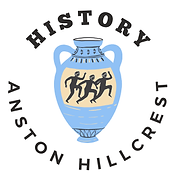
Here, you will find details about the National Curriculum for history and how we integrate history into our learning journeys at Anston Hillcrest Primary School.
Our Goals
At Anston Hillcrest, through our Learning Means the World Curriculum, we aim to develop each child's historical knowledge, curiosity, and understanding of the past. Our structured curriculum is designed to equip children with the skills to engage in informed historical inquiry, critically evaluate sources of evidence, and explore the impact of historical events on societies and cultures with growing independence.
Why?
Enhancing children's historical knowledge, curiosity, and appreciation for the past through a structured curriculum not only enriches their educational experience but also equips them with essential skills for success both in school and beyond. Developing an awareness of different cultures, events, and perspectives is vital to children's holistic development, and our history curriculum provides the foundation for this growth. Through the study of history, children develop critical thinking, empathy, and a sense of responsibility as they learn to reflect on the past to understand the present and shape the future.
Our History Curriculum
History at Anston Hillcrest Primary is taught through thematic units that combine historical knowledge, critical thinking, and enquiry-based learning.
The satellite overview outlines the thematic units that feature History, showcasing the objectives and skills being developed throughout the school.
Children explore key historical events, people, and changes over time, fostering an understanding of chronology and the impact of the past on the present.
How is History taught?
History is taught through a combination of subject knowledge, historical skills, enquiry and fieldwork. Learning takes place both inside and outside the classroom.
What do we learn about in History?
Within the thematic units we will be learning about the following:
Old Things
Wars (World Wars, Civil Wars)
The Ancient Greeks
The Inuits
Roman Empire and Invasions
Inventors e.g. Thomas Edison
The Saxons
The Vikings
The Mayans
The Benin
Famous historical figures
Broadcasting
Religions
Democracy
Transport
Extinction
Animation
Technology e.g. the Internet and World Wide Web
The Moon Landing
The sinking of the Titanic
Significant local history figure / event
Apartheid / Anti-Semitism
Discovery of America / Native Americans
Legacy
Who do we learn about in History?
We learn about the following key historical figures as well as other individuals:
Thomas Edison
Pocahontas
Josephine Baker
Thomas Barnardo
Sir Ranulph Fiennes
Queen Elizabeth II
Queen Victoria
Ada Lovelace
Mary Anning
Flora Drummond
Elizabeth Blackwell
Ignatius Sancho
Walt Disney
Mother Teresa
Neil Armstrong
Roman Emperors and rulers
Ragnar Lothbrok
Harold Godwinson
Martin Luther-King
Nelson Mandela
Rosa Parks
Various World Leaders
Tim Berners-Lee
John Logie Baird
Steve Jobs
Carl Linnaeus
Winston Churchill
Adaptations
At Anston Hillcrest, our history curriculum for disadvantaged children, including those with SEND is adapted through the use of historical artefacts, and visual storytelling to bring the past to life.
Sensory activities, such as handling replica objects and exploring costumes, enhance engagement. Simplified texts, visual supports, and role-play opportunities allow children to understand historical events and figures in a meaningful way.
Pupil Voice
'I loved learning about Neil Armstrong and about the moon landing. I would like to be an astronaut when I am older.'
'I enjoyed learning about the Apollo 11 mission!'
'History tells us what has happened in the past. It helps us to also think about our future.'
'I enjoyed learning about Tim Berners-Lee and the history of the World Wide Web!'
History Showcase
 |  |  |
|---|---|---|
 |  |  |
 |  |  |
 |  |  |
 |  |  |
 |  |  |
 |  |  |
 |  |  |
 |  |  |


